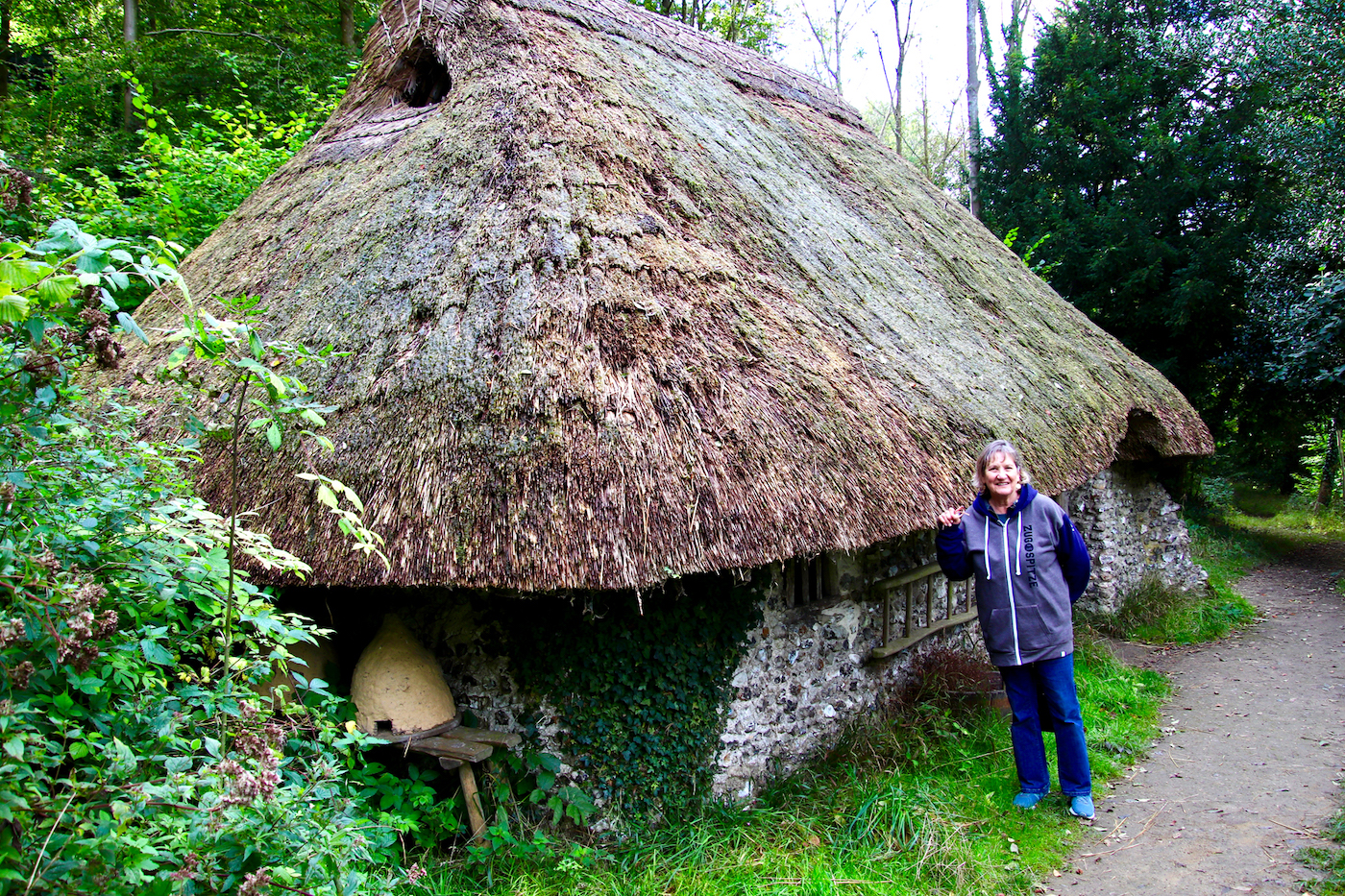Day of the Living Museum

The man was using a hatchet to make a spoon out of a log. “That’s the way it used to be done,” he told us. “People needed things to do indoors when it was cold and damp.”
I zipped up my raincoat. “That’s why we have Netflix.”
We were visiting the Weald and Downland Living Museum in Singleton, England, a large outdoor museum of houses, barns, and villages from the 1300s to 1800s that had been moved there from all over Southern England. The sun poked out from behind a huge cloud. I took a quick photo of the spoon guy.
Back in Santa Barbara it was eighty degrees and sunny. Alan and Adrienne loved it. They were staying in our house. We were staying in their house in Sussex.
“What’s the weather app say?” I asked Pat.
“Fifty degrees.”
“Not bad, what’s the high?”
“That is the high.”
“Any chance of rain?”
“Yup.”
“When?”
“Every day we are here.”
We walked along the gravel path of Weald and Downland to a thatched-roof “Poplar Cottage” built in the 1600s. Upstairs was a bedroom (called a solar) with a romantic view of the thatching above. “Probably had running water… when it rained.”
“Don’t say rain,” Pat said. “I forgot my raincoat. You’d probably lend me yours though, right?”
“I’d love to, Dear, but, ah, the zipper is stuck.”
“So much for the age of chivalry.”
There was also a cradle in the bedroom. “Wonder how long it takes to whittle a baby spoon with an axe?”
“About the same time it would take to thaw out after breastfeeding.”
We continued on to a one-room schoolhouse. It contained a painting of Jesus, a map of the British Isles, and a movable chalkboard that said: “Children should be seen and not heard.” I think the chalkboard in my grade school said the same thing.
Our next stop was a medieval cottage that had once been in the village of Hangleton, probably built in the 1200s. Inside was a large open room with an oven and a hearth, both of which, in my opinion, should have been working on a day like today. The village itself died due to an economic change. And because of Black Death.
“Don’t touch anything.” I suggested.
“Too late,” Pat said. She waved her hand in front of my face. “But I won’t touch you if you give me your raincoat.”
“Wow, just like our vows: ‘Til Black Death do us part.’”
We continued on. I walked well behind Pat so I could keep my eye on her. We discovered an old barn from Cowfold. It had been dated by dendrochronology (tree-ring dating). The trees used in the construction were felled in 1536. Across from the barn was a field with a cow with large horns. It stared at us chewing slowly and deliberately. We took turns mooing at him. He was unimpressed. So we headed for our final village stop, a watermill from the 1600s that was still in operation. It ground corn using two millstones powered by a waterwheel.
“The water comes from a pond above us,” the operator told us. “The water ends up in the pond just below us. At night, we pump all the water from the lower pond back to the upper pond for next day’s tours.”
“We were early recyclers,” his partner said.
We headed for the parking lot. The other thing we exchanged with Adrienne and Alan was our cars. They joked about Americans driving on the wrong side of the road. But at least, for the most part, our roads had two sides. Many of the roads we took to get to Weald and Downland were the width of one car.
“How are your toes?” Pat asked. When I drove they curled under in sheer terror.
“Better. How is your neck?” Pat climbed into the passenger seat and moved her head toward the middle of the car, as far away from the foliage as possible.
“A little stiff. But I guess the folks that lived in all these old villages would have loved to have a car to get around.”
We pulled onto the road. A tour bus came right at us. “Maybe,” I said.
PHOTO:
A) Pat in front of a 1600s thatched-roof “Poplar Cottage” at Weald and Downland Living Museum in Singleton, England







